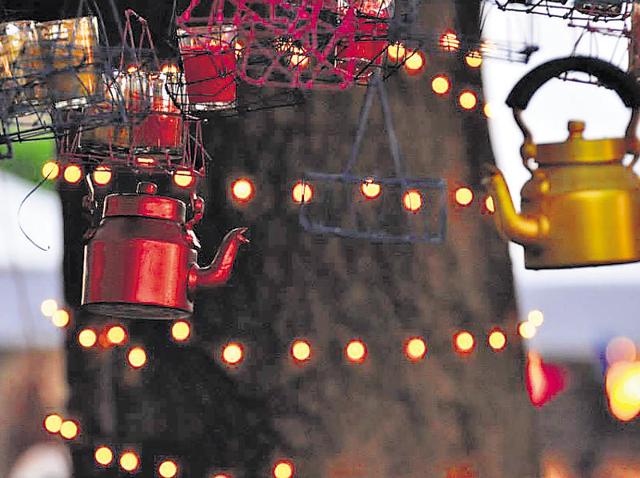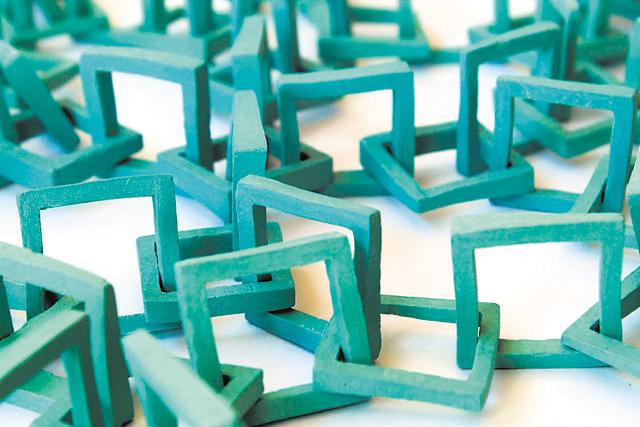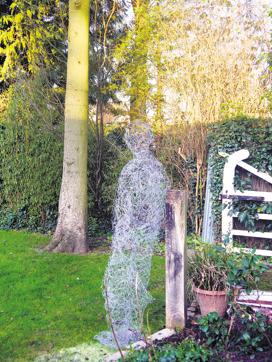Walk through a wonderland at Kala Ghoda
Cutting chai glass installation to pottery sessions, this year’s art festival will be more of hear, touch and feel
Walk through giant works of art, take a bunch of selfies and leave behind little art works of your own, at this year’s Hindustan Times Kala Ghoda Arts Festival.

In a city starved of public art, the interactive installations placed along the streets during KGAF are always a huge hit. Thousands throng to them each day to see, hear, touch and feel.
Read more: Kala Ghoda fest to be twice as nice
This year too, as the festival returns from February 6 to 14, 50 large and interactive installations will dot the area, focused on the theme Without Borders, says visual arts co-curator Heeral Akhaury.
Artist Seema Kohli, for instance, has created a giant installation using 1,000 coloured cutting chai glasses and 700 glass holders.
“Cutting chai as a phrase originated in Mumbai. It is one cup of chai shared between more than one person. Hence the installation talks of the idea of dialogue, bonding, communication, community and sharing in the megacity,” Kohli says.
Artist Purva Pandit, meanwhile, is creating a canopy of bicycles painted in bright acrylic colours, which will reflect those colours on the street below. “The idea is for people to have fun with vivid colours,” says Akhaury.
You can also create your own art, of a sort, any day of the week at this year’s KGAF.
In response to popular demand, the free weekend pottery sessions at the CSMVS grounds have been made a daily affair. “This is an interesting corner where people can experience clay and the joy of creating something with their hands,” Akhaury says.

The pottery corner will also feature a potters’ market, where about one dozen clay and ceramic artistes will create and sell their wares and invite the audience to help them on the wheel.
“Viewers will be encouraged to create small animals at the potters’ corner and leave them under a tree. Over the days this ‘installation’ will keep growing,” says Anjani Khanna, co-organiser of the pottery corner. “We will also leave small clay circles, triangles and stars around, to be painted or written on by visitors. All of these will then be hung from a tree, giving shape to another collective installation.”
The visual experience on the streets, as always, will be accompanied by culinary experiences, with food stalls on Rampart Row offering scrumptious desserts and chaat stalls, says Roxanne Bamboat, a food writer and co-curator of this section.
Visitors can also browse and buy from a total of 76 handicraft and textile stores.
“Our preference this year is for entrepreneurs and NGOs who produce eco-conscious traditional products,” says curator Vidula Warawdekar. “As usual, we also ensure that none of the exhibitors has a retail outlet in Mumbai or has exhibited at the festival before. This way we ensure that we offer the visitors something new each year.”
Another big draw, the street performers, will be back too.
Puppeteers will perform at the museum grounds from 11 am to 9 pm daily. At intervals, traditional Rajasthani Kachighodi dancers, who perform wearing horse costumes, will invite visitors to shake a leg.
“This time around the Behrupiyas [traditional artistes who take on different avatars] will appear as monkeys and as deities such as Ram and Hanuman, and engage with people,” adds curator Varsha Karale.
CROSSING THE THRESHOLD:WITHOUT BORDERS
A look at some of the installations you can expect to see at this year’s KGAF:
Cutting Chai by Seema Kohli: A giant installation using 1,000 coloured chai glasses and 700 glass holders, representing shared dialogue, bonding and community
Chhoti Rickshaw Badi Savari by Nayna Soparkar: Artists paint their vision in colours and mixed media on Plaster of Paris autorickshaws, celebrating the spirit of the three-wheeler
Unity by Bhavesh Mohan Davane: A canopy hanging from a tree, showcasing a map of India without boundaries
History of Kala Ghoda by Ambrish Patange: Exploring the art precinct’s past through a fun reinterpretation of the original Kala Ghoda statue that gave the area its name
Nautral-Artificial by Snigdha Karmahe: A live painting and installation where the artist will perform around a tree, in slow, detailed movements, mirroring yoga poses, representing nature, inherent knowledge and universality
Tower of Babel by Ami Patel & Swaroop Biswas: A collection of 16 installation reimagining the Biblical symbol of chaos for modern times, exploring how technology has created a single world order where varied languages are no longer a barrier in communication.
Time Zone by Vinod Narkar: Exploring the concept of eternity through the Mobius strip
Chitra Sankaran’s paper origami canopy
Barbed Wire Figures by Rekha Sameer: A series of sculptures of human forms created from barbed wire, to question whether borders are within and without

The Phoenix by Aditi Babel: Signifying freedom of thought, ideas and speech
Mural by Joel Bergner: A community art project on women’s safety and empowerment, created by the Brooklyn-based artist in collaboration with city students
World Citizen by Devaki Singh: A wrought-iron artwork representing how we move around the world more than ever but remain connected and desperate to belong
A Fish out of Water by Rahul Das: Reimagining species to represent a world without borders
Mumbai Live Canvas by Pearl Academy: Students will paint live, through the duration of the festival
Existence::Creation::Universe by Subina Aurora Khaneja: An installation that uses wheat, rice, brass, steel etc to represent the greatness of the sun, the moon, and human evolution
Metal Scrap Animal Jungle – Deers by Mithu Dholna
Moon Crescent with Large Balloons by Lekha Washington
Chakras walk-through by Deshna Kasliwal
HARMONIAURA by Ruchi Sheth: Mosaics of Abdul Kalam and Mahatma Gandhi promoting an aura of harmony among different peoples and between humanity and nature
ENTRY IS FREE AND OPEN TO ALL. TO VIEW THE FULL LIST OF INSTALLATIONS, GO TO kalaghoda.hindustantimes.com
Stay updated with all the Breaking News and Latest News from Mumbai. Click here for comprehensive coverage of top Cities including Bengaluru, Delhi, Hyderabad, and more across India along with Stay informed on the latest happenings in World News.
Stay updated with all the Breaking News and Latest News from Mumbai. Click here for comprehensive coverage of top Cities including Bengaluru, Delhi, Hyderabad, and more across India along with Stay informed on the latest happenings in World News.





